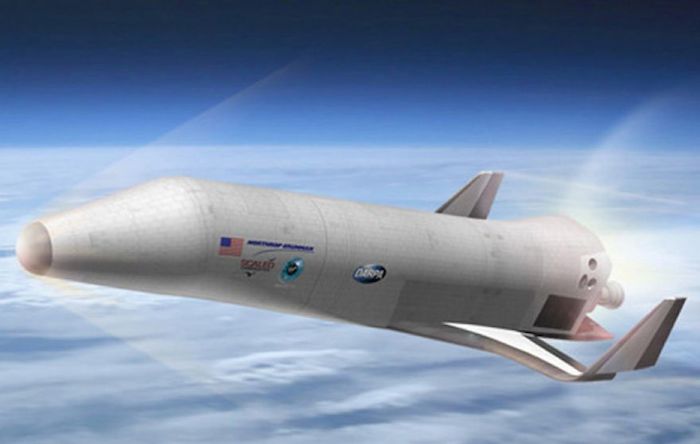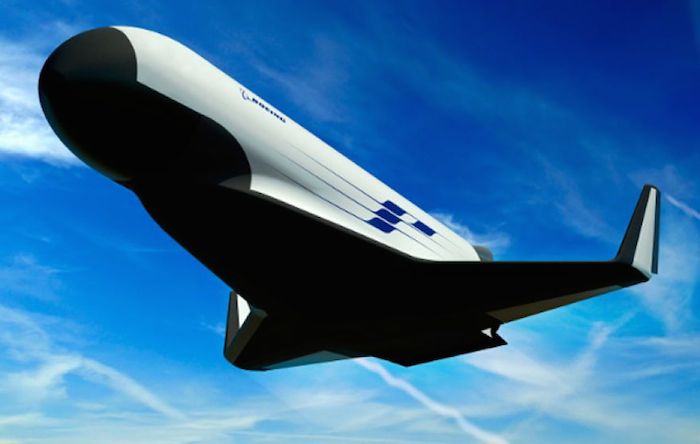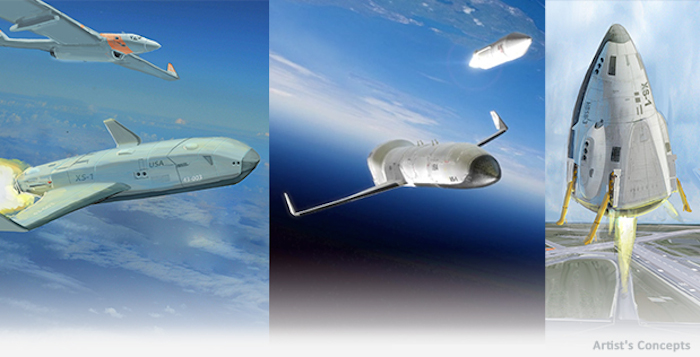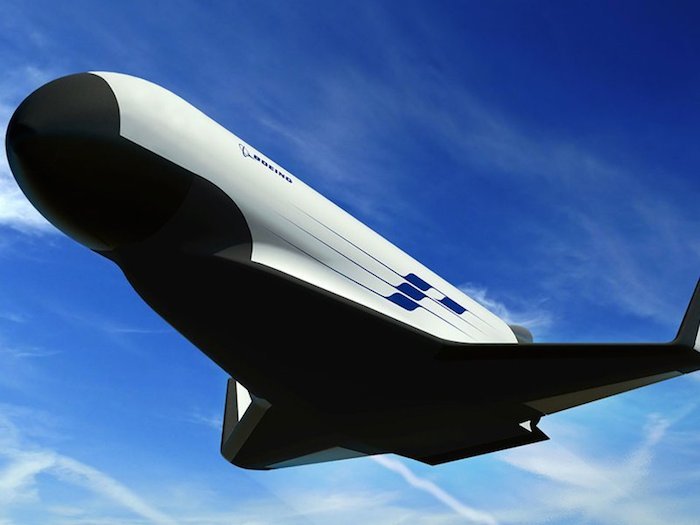
The U.S. military's Defense Advanced Research Projects Agency (DARPA) will soon select a company to build its robotic XS-1 space plane, according to media reports.
DARPA has entered the final stages of the selection process, in which it will ultimately choose one company to construct the space plane, Air Force Magazine reported last week.
In Phase 1 of the XS-1 program, DARPA awarded prime contracts to three companies, each of which will work with a commercial launch provider: Boeing (working with Blue Origin), Masten Space Systems (working with XCOR Aerospace) and Northrop Grumman (working with Virgin Galactic).
However, the Phase 2 contractor won't necessarily be chosen from the three Phase 1 participants, according to the Air Force Magazine report.

Technical goals
The XS-1 space plane will consist of a reusable booster vehicle and an expendable upper stage. According to the DARPA website, the XS-1 program has four primary technical goals:
- Fly 10 times in a 10-day period, to demonstrate efficient, aircraft-like access to space.
- Fly fast enough to allow the use of a small (and therefore cheap) expendable upper stage.
- Launch a 900-lb. to 1,500-lb. (408 to 680 kilograms) payload, to demonstrate a launch capability that could support both military and commercial missions. The same XS-1 vehicle could eventually also launch future payloads in excess of 3,000 lbs. (1,360 kg), by using a larger upper stage.
- Reduce the cost of access to space to about $5 million per flight for payloads of at least 3,000 lbs.
"Structures made of advanced materials, cryogenic tanks, durable thermal protection, and modular subsystems would make possible a vehicle able to launch, fly to high speeds and then land in a condition amenable to rapid turnaround and launch with the next payload. Reusable, reliable propulsion would also be essential for a low-cost and recurring flight capability," DARPA officials wrote on the agency's website last year.

Flight by 2020?
If everything goes according to plan, the XS-1 could get off the ground just a few years from now.
"After downselect, a critical design review would take place in 2018, and a series of flights could be made as early as 2020," Air Force Magazine's John Tirpak wrote in his story last week. "One of the program requirements is to fly 10 suborbital or orbital missions in as many days, achieving space operations with ‘aircraft-like’ frequency, DARPA said. If successful, a 'public-private partnership' model of operating the vehicles could be adopted, DARPA documents show."
Space.com contacted Jess Sponable, program manager of XS-1 at DARPA's Tactical Technology Office, about the Air Force Magazine report and projected timelines for XS-1 milestones.
"Absolutely, we are moving forward. But we never say so until it is a done deal," Sponable said.
Quelle: SC
---
Update: 25.05.2017
.
A DARPA concept video of the Experimental Spaceplane 1, or XS-1. DARPA
Boeing on Wednesday won a U.S. military contract to develop an experimental space plane that could launch and land on the Space Coast in 2020.
The Defense Advanced Research Projects Agency selected Boeing’s “Phantom Express” concept to advance to the next phases of its Experimental Spaceplane program, or XS-1.
The XS-1 program aims to develop an affordable, on-demand launch option for national security satellites, one that could fly 10 times in 10 days.
Asked where the flight activity would occur, a DARPA spokesman responded in an email, “The Cape.”
Air Force maps have identified Launch Complexes 16 and 20 as sites the XS-1 program could potentially use. Landings presumably would target Kennedy Space Center’s former shuttle runway, now operated by Space Florida.
Boeing already occupies several former shuttle hangars at KSC, one for assembly of the Starliner crew capsule and two for another military space plane, the Air Force's semi-classified X-37B mini-shuttle, which landed at KSC for the first time earlier this month.
Boeing said only that it is reviewing launch and landing sites. Space Florida declined to comment.
Described as the size of a business jet, the reusable Phantom Express will launch vertically to hypersonic speeds, powered by a version of a space shuttle main engine called the AR-22, provided by Aerojet Rcoketdyne.
A small, expendable upper stage, envisioned as liquid-fueled but to be determined by Boeing, will be deployed to deliver payloads roughly 3,000 pounds to orbit while the space plane booster returns to a runway landing.
The program hopes to fly such missions for $5 million, compared to tens of millions for conventional rockets that may take a year or more to order.
“The XS-1 would be neither a traditional airplane nor a conventional launch vehicle but rather a combination of the two, with the goal of lowering launch costs by a factor of ten and replacing today’s frustratingly long wait time with launch on demand,” said Jess Sponable, DARPA program manager.
DARPA said the quick-launch technology would "revolutionize the nation’s ability to recover from a catastrophic loss of military or commercial satellites, upon which the nation today is critically dependent."
The value of Boeing's contract award was not specified, but DARPA previously estimated it would be around $140 million — small change for a rocket development program. Boeing also will invest in the project.
The XS-1 program's first phase included Boeing, which originally was partnered with Blue Origin; Masten Space Systems, working with XCOR Aerospace; and Northrop Grumman, partnered with Virgin Galactic.
Plans anticipate design and testing proceeding through 2019, including firing the main engine system 10 times in 10 days.
In 2020, a series of shakedown cruises would be followed by the attempt to launch 10 times on 10 consecutive days, first without payloads and later with the demonstration payload between 900 pounds and 3,000 pounds.
“Phantom Express is designed to disrupt and transform the satellite launch process as we know it today, creating a new, on-demand space-launch capability that can be achieved more affordably and with less risk,” said Darryl Davis, president, Boeing Phantom Works.
Quelle: Florida Today
+++
DARPA selects Boeing for spaceplane project

WASHINGTON — The Defense Advanced Research Projects Agency announced May 24 that it has picked Boeing to develop an experimental reusable first stage with the promise of lowering launch costs for medium-sized payloads.
Boeing will develop its “Phantom Express” vehicle for phases 2 and 3 of DARPA’s Experimental Spaceplane 1 (XS-1) program, which has the goal of performing 10 flights in 10 days to demonstrate responsive and low-cost launch. Phase 2 will cover development of the vehicle and ground tests though 2019, with a series of 12 to 15 test flights planned for phase 3 in 2020.
DARPA spokesman Rick Weiss said the value of the award to Boeing is $146 million. The award is structured as a public-private partnership, with Boeing also contributing to the overall cost of the program, but Boeing declined to disclose its contribution.
“As it’s a competitive market, we do not plan to disclose our investment,” Boeing Phantom Works spokeswoman Cheryl Sampson said. “We are making a significant commitment to help solve an enduring challenge to reduce the cost of space access.”
The Phantom Express vehicle will take off vertically, with an upper stage carrying a satellite payload mounted on top of the fuselage. After releasing the upper stage, the suborbital vehicle would glide back to a runway landing.
“Phantom Express is designed to disrupt and transform the satellite launch process as we know it today, creating a new, on-demand space launch capability that can be achieved more affordably and with less risk,” said Darryl Davis, president of Boeing Phantom Works, in a company statement.
Phantom Express is powered by an Aerojet Rocketdyne engine designated the AR-22, based on the Space Shuttle Main Engine (SSME). In a statement, Aerojet Rocketdyne said it is providing two such engines “with legacy shuttle flight experience” using parts from both the company’s and NASA inventories of earlier versions of the SSME. The engines will be assembled and tested at NASA’s Stennis Space Center in Mississippi.
That engine represents an apparent switch in Boeing’s XS-1 concept. In phase 1 of the program, Boeing was partnered with Blue Origin, with the expectation Blue Origin would provide an engine for the spaceplane. “We selected the Aerojet Rocketdyne engine as it offers a flight proven, reusable engine to meet the DARPA mission requirements,” Sampson said.
DARPA announced the XS-1 program in 2013 as an effort to develop a reusable first stage that, coupled with an expendable upper stage, could lower the cost of launching payloads weighing up to 2,200 kilograms by an order of magnitude from the roughly $50 million the government pays for Minotaur 4 launches.
“The XS-1 would be neither a traditional airplane nor a conventional launch vehicle but rather a combination of the two, with the goal of lowering launch costs by a factor of ten and replacing today’s frustratingly long wait time with launch on demand,” said Jess Sponable, DARPA XS-1 program manager, in an agency statement.
Sponable, in past discussions of the XS-1, noted the use of “spaceplane” in the program’s name was meant to describe the goal of aircraft-like operations, not the design of the vehicle itself.
In 2014, DARPA announced three phase 1 awards for initial studies of the XS-1 concepts. In addition to Boeing, DARPA provided awards to Masten Space Systems, working with XCOR Aerospace; and Northrop Grumman, working with Virgin Galactic.
DARPA issued a call for proposals in April 2016 for phases 2 and 3 of the program. Boeing, Masten and Northrop Grumman all submitted proposals for phase 2, but DARPA also allowed other companies to compete. DARPA did not disclose the number of proposals it received.
A key aspect of the program retained from its earlier days is a requirement to carry out 10 flights in 10 days. In phase 2, the vehicle will fire its engine in ground tests 10 times in as many days, with the 10 flights in 10 days, at speeds up to Mach 5, in phase 3.
Later test flights of the Phantom Express will go up to Mach 10, another original goal of the program. At least one test flight will carry an upper stage that would place a demonstration payload into orbit.
DARPA and Boeing recently worked together on another program that attempted to provide less expensive and more responsive space access. DARPA selected Boeing in March 2014 to develop a launch vehicle for its Airborne Launch Assist Space Access (ALASA) program. The ALASA rocket, launched from an F-15 aircraft, was intended to place satellites weighing up to 45 kilograms into orbit for $1 million a launch, and do so on 24 hours’ notice.
ALASA suffered problems, though, linked to its use of an unconventional “mixed monopropellant” called NA7, a mixture of nitrous oxide and acetylene. Ground tests found that NA7 was less stable than expected and, in November 2015, DARPA changed the goals of ALASA to continue testing NA7, scrapping development of the launch vehicle.
DARPA, in its announcement of the XS-1 award, said that autonomous flight termination systems and related autonomous flight technologies developed as part of the ALASA program will be applied to Boeing’s Phantom Express vehicle.
Quelle: SN
---
Update: 14.06.2017
.
Boeing, DARPA to base XS-1 spaceplane at Cape Canaveral

A reusable suborbital spaceplane the size of a business jet being developed by Boeing and the Defense Department’s research and development arm could be launching and landing at Cape Canaveral in 2020, officials said after the defense contractor won a competition last month to design and test the vehicle.
Designed for rapid reusability, the XS-1 spaceplane will take off vertically like a rocket — without a crew — deploy an upper stage after traveling beyond the edge of space, then return to landing on a runway for inspections and reuse.
The Defense Advanced Research Projects Agency, or DARPA, selected Boeing to finish designing the spaceplane last month. Boeing beat competitors Northrop Grumman and Masten Space Systems to win the $146 million contract.
Boeing and DARPA are developing the spaceplane in a cost-sharing public-private partnership arrangement, but Boeing did not disclose how much it is spending on the program.
When operational after a series of suborbital and orbital test flights, the XS-1 and its expendable upper stage could place satellites weighing up to 3,000 pounds (1,360 kilograms) into low Earth orbit several hundred miles above the planet.
“The XS-1 would be neither a traditional airplane nor a conventional launch vehicle but rather a combination of the two, with the goal of lowering launch costs by a factor of ten and replacing today’s frustratingly long wait time with launch on demand,” said Jess Sponable, DARPA program manager, in a press release. “We’re very pleased with Boeing’s progress on the XS-1 through Phase 1 of the program and look forward to continuing our close collaboration in this newly funded progression to Phases 2 and 3 — fabrication and flight.”
The Defense Department envisions the Experimental Spaceplane, or XS-1, program as an option for rapid call-up to replace a lost military or commercial satellite, available to launch within days instead of the months or years needed today.
An end goal for the XS-1 program is to launch 10 times in 10 days, with recurring operating costs as little as $5 million per flight, including the disposable upper stage, according to DARPA.
Boeing calls its XS-1 test vehicle the Phantom Express, a winged craft the size of a business jet that will launch to the edge of space and release an expendable upper stage, which would fire to inject the mission’s payload into orbit. The reusable first stage would turn around and fly back to the launch site.
Rick Weiss, a DARPA spokesperson, said Cape Canaveral will be the base for Phantom Express test flights and launch operations. He did not say which launch pad the spaceplane will use.
The spacecraft booster would return to land at one of two runways on Florida’s Space Coast: Kennedy Space Center’s Shuttle Landing Facility, a three-mile-long landing strip, or the Skid Strip at Cape Canaveral Air Force Station.
“Phantom Express is designed to disrupt and transform the satellite launch process as we know it today, creating a new, on-demand space-launch capability that can be achieved more affordably and with less risk,” said Darryl Davis, president of Boeing Phantom Works.
Boeing officials said the Phantom Express would employ operation and maintenance principles similar to modern aircraft.
The U.S. Air Force’s X-37B space plane, similar in appearance to the XS-1 but different in function, is also built by Boeing.
The Phantom Express booster stage would be powered by a single Aerojet Rocketdyne AR-22 engine, a version of the space shuttle main engine, burning liquid hydrogen and liquid oxygen propellants.
Boeing originally partnered with Blue Origin, the space company founded by Amazon.com’s Jeff Bezos, as an engine provider for the XS-1 program, but later switched to an Aerojet Rocketdyne engine, according to Cheryl Sampson, a Boeing spokesperson.
“We conducted trade studies with Blue Origin in the first phase of the program,” Sampson wrote in an email to Spaceflight Now. “Boeing selected the Aerojet Rocketdyne engine for this next phase as it offers a flight proven, reusable engine to meet the DARPA mission requirements.”
Aerojet Rocketdyne said it will provide two engines for the XS-1 program with “legacy shuttle flight experience to demonstrate reusability, a wide operating range and rapid turnarounds.”

The engines will be designated as AR-22 engines, Aerojet Rocketdyne said in a press release. Technicians at NASA’s Stennis Space Center in Mississippi, where Aerojet Rocketdyne assembles and tests rocket engines, will create the AR-22 engines from parts left over from early versions of the shuttle main engine, the company said.
“As one of the world’s most reliable rocket engines, the SSME is a smart choice to power the XS-1 launch vehicle,” said Eileen Drake, Aerojet Rocketdyne CEO and president. “This engine has a demonstrated track record of solid performance and proven reusability.”
The Phantom Express booster stage will have advanced, lightweight composite cryogenic tanks to hold the super-cold propellants feeding the AR-22 engine. Hybrid metallic-composite wings and control surfaces on the spaceplane wi






